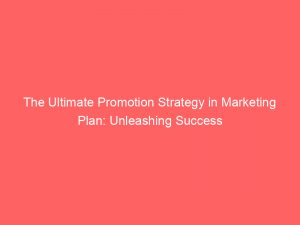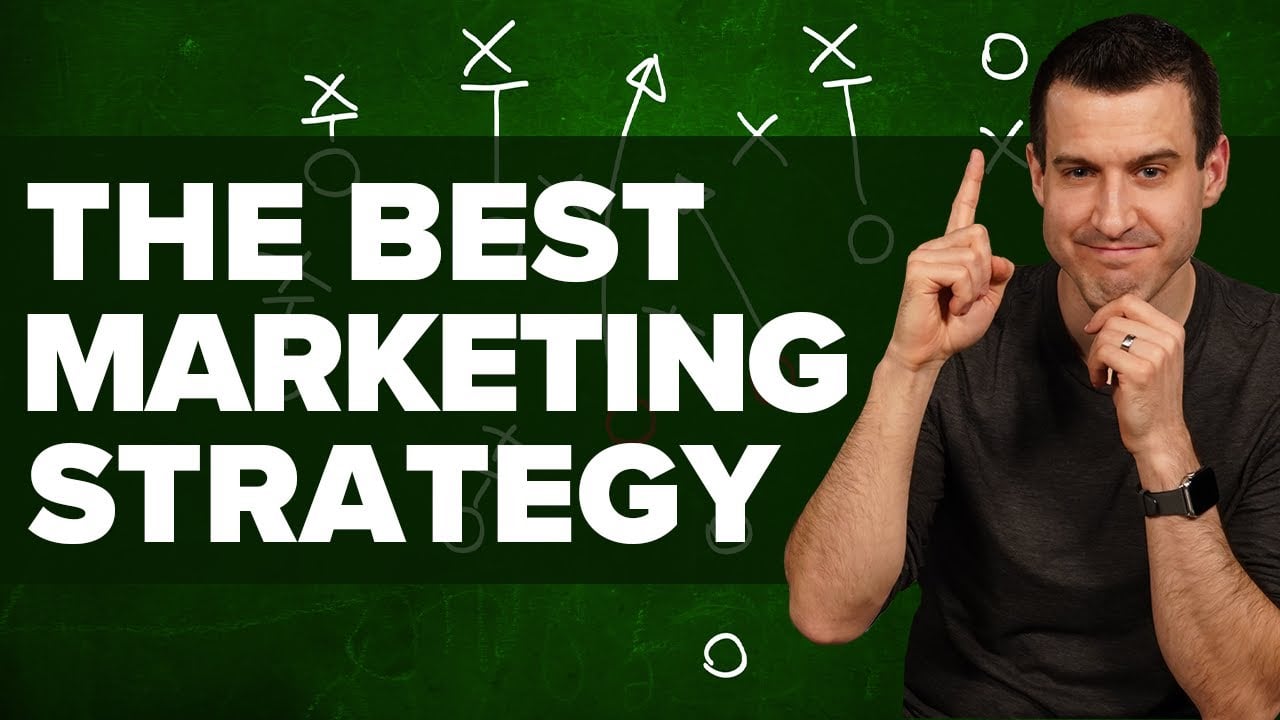In today’s competitive business landscape, a well-executed promotionstrategy can make all the difference in capturing the attention of consumers and driving sales.
From the power of email marketing to the effectiveness of loyalty programs, the arsenal of promotional tactics available to marketers is vast and ever-evolving.
Join us as we dive into the exciting world of promotionstrategy in a marketing plan, where creativity and strategic thinking combine to create compelling campaigns that leave a lasting impact.
Table of Contents
- promotion strategy in marketing plan
- Email Marketing
- Retargeting
- Referral Marketing
- Event Marketing
- FAQ
- What are the 4 types of promotional strategies?
- What are the 5 P’s of promotion?
- What are the 3 P’s of promotional strategy?
- What are some potential drawbacks to relying heavily on price discounting as a promotion strategy in a marketing plan?
promotionstrategy in marketingplan
A promotion strategy in a marketing plan refers to the various tactics and methods used to communicate and promote a brand or product to the target audience.
These strategies aim to create awareness, generate interest, and ultimately drive sales.
Some common promotion strategies include email marketing, retargeting, referral marketing, event marketing, aligning with special causes, customer reviews, loyalty programs, free samples and trials, coupons and deals, paid advertising, content marketing, and sponsorships.
Implementing these strategies effectively and measuring their results are crucial for achieving success in marketing.
Key Points:
- Promotion strategy in marketing plan involves tactics and methods to communicate and promote a brand or product
- Goal of promotion strategies is to raise awareness, generate interest, and increase sales
- Examples of promotion strategies include:
- Email marketing
- Retargeting
- Referral marketing
- Event marketing
- Special cause alignment
- Customer reviews
- Loyalty programs
- Free samples
- Coupons and deals
- Paid advertising
- Content marketing
- Sponsorships
- Effective implementation and measurement of promotion strategies are important for marketing success.
Check this out:
💡 Did You Know?
1. In the late 1800s, the tobacco company W.D. & H.O. Wills was one of the first to use promotional tactics in their marketing plan. They included collectible cards in their cigarette packs featuring famous people, landscapes, and historical events, sparking the trend of trading cards that continues today.
2. One of the most successful promotional strategies in marketing history is the “limited time offer” tactic. This technique creates a sense of urgency among consumers, leading them to make quicker purchasing decisions. Originally popularized by fast-food chains, it has since been adopted by various industries and continues to be a highly effective marketing tool.
3. Guerrilla marketing” is a promotion strategy that involves unconventional or unexpected methods, often relying on creativity and imagination rather than a large budget. It can include anything from viral social media campaigns to event stunts on public streets, aiming to grab attention and create a memorable brand presence.
4. A less known but successful promotion strategy is “cause marketing,” where companies align themselves with a particular cause or charity. By associating their brand with a social issue, companies not only generate brand loyalty but also contribute positively to society, further enhancing their reputation.
5. To keep customers engaged and rewarded, some companies implement a “referral marketing” strategy. This involves incentivizing existing customers to refer new customers to their products or services. It not only increases customer acquisition but also builds a sense of community, as people tend to trust recommendations from friends and family.
Email Marketing
Email marketing is a powerful tool that allows businesses to target their audience directly, ensuring their messages are received by interested individuals. It involves sending newsletters, exclusive content, product information, special deals, and coupons to subscribers on your mailing list.
One of the key advantages of email marketing is its cost-effectiveness. Compared to traditional advertising methods like TV or radio ads, email marketing allows businesses to reach a larger audience at a fraction of the cost. By segmenting your email list, you can tailor your messages to specific groups and personalize the content to meet their needs.
Furthermore, emails provide a direct line of communication with your customers, allowing you to build strong relationships and foster customer loyalty. By consistently delivering valuable and relevant content, you can position your brand as an authority in your industry and increase the likelihood of repeat business.
Retargeting
Retargeting is a promotion strategy that targets customers or potential customers who have high purchase intent. This strategy involves sending reminder emails to customers who abandoned their online shopping carts or showing targeted advertisements to past customers.
The main objective of retargeting is to remind customers about products and services they showed interest in but did not purchase. By reaching out to these individuals through email or targeted ads, you can capture their attention, remind them of the benefits of your offerings, and encourage them to complete their purchase.
Retargeting is an effective way to convert warm leads into customers. By specifically targeting individuals who have already shown interest in your brand, you increase the likelihood of converting them into paying customers. It also allows you to maximize your marketing budget by focusing on individuals who are more likely to make a purchase.
Referral Marketing
Referral marketing is a strategy that encourages customers to refer their friends to your brand with special deals and incentives. It leverages the power of word-of-mouth marketing, which is known to be one of the most effective forms of advertising.
By providing incentives to customers who refer their friends, you not only increase customer loyalty but also acquire new customers. People are more likely to trust recommendations from friends and family, making referrals a valuable source of new business.
To implement a successful referral marketing program, it’s important to offer incentives that motivate customers to refer others. These incentives can be in the form of discounts, exclusive offers, or even rewards such as cash or free products. By rewarding your customers for their referrals, you create a win-win situation where both the referrer and the new customer benefit.
Event Marketing
Event marketing is a powerful promotion strategy that allows businesses to participate in, sponsor, or host events to promote their brand or product. This strategy includes activities such as attending conferences, trade shows, webinars, and community events.
Events provide businesses with a unique opportunity to connect with their target audience on a personal level. By participating in industry-specific events, businesses can showcase their products, engage with potential customers, and build brand awareness. Sponsorships can help increase brand visibility and credibility, as well as provide access to a relevant and engaged audience.
Furthermore, hosting events can help businesses establish themselves as thought leaders and industry experts. It allows businesses to share their knowledge, educate their audience, and position themselves as authorities in their field. This can lead to increased brand loyalty and trust among customers.
Event marketing also allows businesses to network with industry professionals and form partnerships that can further enhance their marketing efforts. By collaborating with other brands or influencers, businesses can tap into new audiences and expand their reach.
Overall, event marketing is a versatile promotion strategy that can be tailored to suit a variety of business objectives. From generating leads and driving sales to building brand awareness and establishing industry authority, events offer numerous benefits for businesses looking to promote their products or services.
Remember, to implement these strategies effectively, it’s crucial to measure your results. Monitor the performance of each promotion strategy and make necessary adjustments to ensure success. By continuously analyzing the data and optimizing your marketing efforts, you can unleash the full potential of your promotion strategy and achieve your marketing goals.
FAQ
What are the 4 types of promotional strategies?
Promotional strategies encompass traditional and online advertising, personal selling, direct marketing, and sales promotions. Traditional advertising involves reaching a wide audience through mediums such as television, radio, print, or billboards. Online advertising, on the other hand, leverages digital platforms to engage with the target market and includes tactics like display ads, social media campaigns, or search engine optimization. Personal selling entails building one-on-one relationships with potential customers, showcasing the product’s benefits and addressing specific needs. Direct marketing utilizes direct communication channels, such as email or direct mail, to directly reach consumers and encourage them to take action. Lastly, sales promotions are designed to stimulate immediate purchases through limited-time offers, discounts, or incentives, enticing customers to buy.
What are the 5 P’s of promotion?
The 5 P’s of promotion are a vital component of marketing strategies. Firstly, Product refers to the goods or services being offered and how they meet the needs and wants of the target market. Price focuses on setting the right price for the product, taking into account factors such as production costs, competitors’ prices, and customer perceptions of value. Promotion entails the various marketing communication activities employed to inform, persuade, and influence potential customers about the product. It includes advertising, public relations, sales promotions, and personal selling. Place refers to the channels and locations where the product is made available to customers. Finally, People encompasses the individuals involved in the marketing process, including customers, employees, and influencers. Understanding and leveraging the 5 P’s of promotion can greatly enhance a brand’s marketing effectiveness and success.
What are the 3 P’s of promotional strategy?
The three P’s of promotional strategy are Product, Price, and Placement. The Product refers to the item or service being offered and it is crucial to have a deep understanding of it. Knowing your product inside out will enable effective communication and persuasion. The second P, Price, is an essential factor as it determines the value perception of the product or service. Setting the right price can attract customers and help position the offering in the market. Lastly, Placement refers to the distribution channels and methods used to make the product available to the target audience. Proper placement ensures that the product reaches customers conveniently and efficiently.
What are some potential drawbacks to relying heavily on price discounting as a promotion strategy in a marketing plan?
Relying heavily on price discounting as a promotion strategy can have several potential drawbacks. Firstly, it may erode the perceived value of the product or service. Customers might start associating the brand only with low prices rather than its quality or unique features. This can lead to a decline in brand loyalty and customers becoming less willing to pay full price in the future.
Secondly, heavy reliance on price discounting can harm the profit margins of a business. Lowering prices to attract customers may result in reduced profitability, especially if the cost of producing or providing the product or service remains the same. This can create financial challenges for the company in the long run as it may struggle to maintain sustainable profit levels and invest in other strategies for growth and innovation.
Enhanced readability and refreshed examples.
Self-Serve DSP Platform • Advertising Platform for Marketers • Performance Marketing Tips • Buy Traffic • Programmatic Advertising












